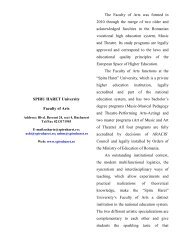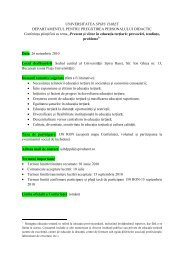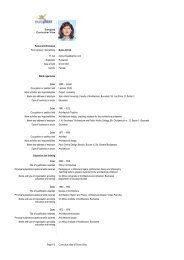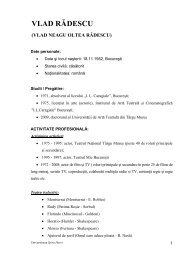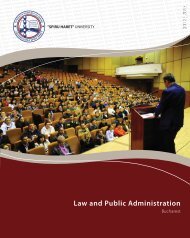details - Universitatea Spiru Haret
details - Universitatea Spiru Haret
details - Universitatea Spiru Haret
You also want an ePaper? Increase the reach of your titles
YUMPU automatically turns print PDFs into web optimized ePapers that Google loves.
The European Union Strategy for the Danube Region- SUERD (EUSDR)Research/ design and professional training opportunitiesGheorghe Ionaşcu, Associate Professor, Phd, ArchitectMOTTO: (…) I believe that this programme of the Honorary International Chair supportingEUSDR should involve the Romanian universities and research institutes more, regardingall the topics in this programme. And maybe this involvement, which I would kindly suggestyou to accept, also has the consequences we have been already experiencing for a few years.We are talking about the higher education internationalisation and I believe that due to theprojects of such a programme we could extend the relationships of collaboration andpartnerships between the participant universities (…).Ecaterina Andronescu, Professor, PhDMinister of Education, Research, Youth and SportBucharest, Senate of Romania, 27 th September 2012On its path to democracy, progress and civilisation, Romania has an upward trend ofdevelopment in the European context, discovering new opportunities of cooperation anddeeper integration on the European continent.Under such circumstances, Romania and Austria initiated a macro-project for a complexdevelopment of the Danube-Black Sea region, to which other riparian states or states in theDanube’s hydrographic basin acceded. Currently, there are 14 European partner states to theEuropean Union Strategy for the Danube Region- SUERD (EUSDR): Austria, Germany,Slovenia, Czech Republic, Slovakia, Hungary, Romania, Bulgaria, Croatia, Serbia, Bosniaand Herzegovina, Montenegro, Republic of Moldavia and Ukraine.The following strategic pillars, formulated by the European documents, support thedevelopment of the strategy:• Connectivity, with a highlight on transport/ navigability for tourism and trade.Romania considers the following concrete actions:- gradually developing the projects on the European Corridor VII,- upgrading the fluvial ports network, as logistic centres on the Danube corridor,- upgrading the access to and from the rural areas,
- increasing the actions in the urban areas, through appropriate developmentprojects.• environment protection, by creating a system of management and control of theenvironmental factors for Romania, in order to provide a sustainable development anda growth in the quality of life.• assuring the social and economic prosperity, by:- new investments for the development of the utilities system and qualityservices,- supporting the SMEs,- reshaping the education and research sector.• consolidating the Danube region for Romania, by:- increasing the institutional capacity of the public administration by involvingthe civil society,- fighting corruption and organised crime, especially in the cross-border region,- fighting against illegal migration and human trafficking.Estimated final impact:By its geo-strategic position in Europe, relative to the Danube and the Black Sea, Romaniamust perform as a unitary coordinator, especially in the context of its own internal challengesand European and zonal convergence objectives.The main practical consequences are:1. unprecedented cooperation level between the international, national and localdimensions,2. immense resources of all types,3. overcoming the territorial national, traditional borders by uniting the efforts of thestates interested in a regional or European cooperation.The main stakeholders are:- the high level ones (The European Commission- DG REGIO, EUSDR- MAE(Ministry of Foreign Affairs) national coordinator, the ministries coordinatingthe priority fields, etc.),
- the Pan-European organisations grouping the towns and areas of the Danubemacro-region,- the local authorities and the respective human communities,- experts, consultants and researchers etc.Provisional conclusions:= EUSDR has a transnational character, imposing a new updating theoretic perspective, onspatial planning and its perspectives, as well as a subsequent exploitation of the macro-regionconcept,= EUSDR is a common programme aiming at demonstrating a superior inter- and intra-statecooperation,= EUSDR must engage a huge amount of resources and stakeholders distributed on a vastterritory, with a great variety of projects (great complexity coordination level andmanagement project).Romania’s strategic priorities within EUSDR are grouped according to fields, as follows:• Transport:- developing a multimodal transport system along the European corridor,connected with the Black Sea;- developing infrastructures based on new technologies and integrated systems(transport, management, monitoring, information);• Energy: transforming the region into a European energy corridor, by:- responsible and efficient capitalisation of the local resources (conventional andrenewable),- developing the production, transport and storage energy capacities,- broadening the access to distribution networks,- fighting against the energy poverty phenomenon.• Environment protection: Integration of environment protection starting with thedesign stage (green knowledge intelligence systems) and development of amanagement and control system of the environmental factors for:- pollution reduction,- elimination of the negative effects in case of disasters,
- bio-diversity protection, including the socio-economically useful one (grazinglands, meadows, domestic animals), capable of assuring the food security ofthe population,- cross-border cooperation in responsible ecological management of theprotected areas (e.g. Portile de Fier National Park),- conservation and extension of the forest areas, parks, green spaces etc.,• Research/design: development of new research centres/ innovative hubs, highlightingthe new eco-efficient technologies.• Tourism and culture: The integrated development of tourism and capitalisation ofthe natural and cultural-historical heritage of the region, by:- developing the specific infrastructure and- intense transnational promotional- sensitising actionsRural development:a) Modernisation of the agricultural sector andb) Diversification of the economic non-agricultural activities, by:- capitalisation of the natural/ environmental resources (forest heritage, fishresources, bio-diversity etc),- revitalisation and re-capitalisation of the cultural heritage (with a highlight ontraditions and professional experiences)• Other priorities:- capitalisation of the IT&C potential of the region and its application in thepublic and private sectors,- involvement of the business environment in developing the EUDSR projects,- promotion of the ecological education projects,- integration of the cultural dimension in the other EUSDR implementationpolicies,- capitalisation of the cultural heritage potential,- public safety and health.<strong>Spiru</strong> <strong>Haret</strong> University participated in all the events related to the successful development ofthe ongoing EUSDR stages and came with various collaboration proposals, considered by theorganizers. Among others, the issue of organising a summer school for increasing theentrepreneurial impact in the area, with the perspective of preserving the traditional and
• coordination of the environment protection measures, of ecological reconstructionand protection of the danube confluents with the pollution risks,• the development of the danube tourism and cooperation with the mountain regiontourism (resorts and rural),• increase of the water quality, rehabilitation of the technical and urban networks ofwater supply and sewage system,• integration of the protection measures to the risks of flooding, land sliding andearthquakes,• re-use by upgrading the infrastructure of the old ports and increase of the numberof jobs.- For the business environment:• better opportunities for the industrial environment, mainly the SMEs• re-launching the local economies,• integration of the products (new brands) and innovative processes at a regional-Danube scale (brand products, innovative equipment and technologies, developmentof the aquaculture, including in the mountain region,• better interstate transborder cooperation.- For Education and research:• adjusting general education to the requirements of the ever-changing economy,• development of vocational education, for new professions and revival of the traditionalones,• adjustment of the curricula in the primary and secondary education to the specificcriteria of the landscape areas (humid, field, mountain, etc)• ecological education at all levels, multi- and trans-national, in a Carpathian-Danubian –Pontic perspective, in order to provide a future sustainabledevelopment in the region,• boosting the development of the civic abilities of behavior, cooperation andcommunication,• new opportunities of research/design for the academia, master andundergraduate students, by building mixed multidisciplinary groups, to
ecommend and devise studies and projects for SUERD that will be implementedin a partnership with local Danube authorities and other interested parties.- For investments and jobs:• increase of investments in the infrastructure, for an economic-social rebirth of theregion,• a higher number of jobs in constructions and in the horizontal industry (constructionmaterials, equipment, etc),• attracting the young people left for work abroad, by means of the new employmentopportunities, in designing and making new investments,• rehabilitation and preservation of the historic-archaeological monuments and theirintroduction into the public circuit of national and European values.Romania, as and initiator and signatory state of the European Union Strategy for theDanube Region – SUERD (EUSDR), a magnet for European funds, considers associationin more research projects, by a creative identification of as many as possible areas ofinterest on the four established pillars. The major projects and initiatives in all 41Romanian counties are included in the future Programme of Territorial Cooperation,meant for implementing SUERD, to which a total amount of EUR11.9 billions will beallocated in the next 7 years.<strong>Spiru</strong> <strong>Haret</strong> University can become an information and participation hub for theacademic staff, who will gather together mixed groups of specialists and access Europeanfunds, by well-defined projects. The national partnership with other central institutions, asthe Association of Municipalities and Towns and the Association of Businessmen – willenable a smoother cooperation with the Danube cities, so as to accomplish interesting anduseful projects for the human communities directly involved. On the other hand, thePartnership with other similar institutions in the Danube states will open a transbordercooperation.To begin with, initiation cycles can be provided (lasting a few days) and seminars, bearingthe features of the SUERD Programme. These events will be decided upon by the <strong>Spiru</strong>
<strong>Haret</strong> University management and made public, including in our Opinia Nationalaweekly publication.Launching of the Honorary International Chair – SUERD (EUSDR)Palace of the Parliament, Senate Hall, September 27-28, 2012, photosAmbassador Liviu BOTA, CIO-SUERDEcaterina Andronescu, Minister of EducationSever Avram, CEO EUROLINK, House of EuropeErich Wendl, European Academy, ViennaSorin Dumitriu, President of the Chamber of Commerce and Industry, BucharestPalace of the Parliament, Senate Hall, 27-28 September 2012Al.T.Bogdan, Prof PhD, Correspondent member of the Romanian AcademyCorneliu Govaliugov, Senate of RomaniaThe Session of Establishing the SUERD – DANUBIUS University, Galati, October25-27, 2012The public debate on October 29-30, 2012 and the Reception to the IPS ArchbishopCasian of GalatiThe map of the Danube BasinThe Danube Basin and the Black Sea


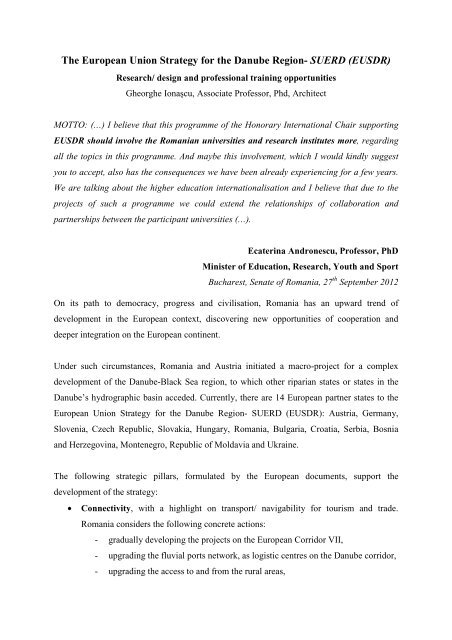
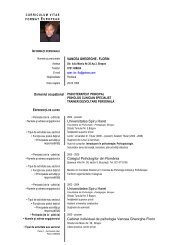
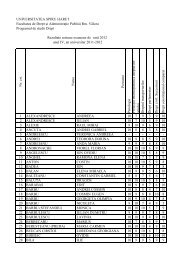

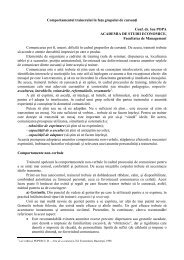
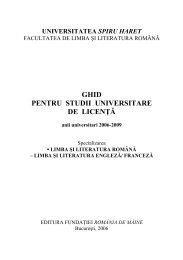
![CV Niculescu G engleza[1] - Universitatea Spiru Haret](https://img.yumpu.com/50881031/1/184x260/cv-niculescu-g-engleza1-universitatea-spiru-haret.jpg?quality=85)
